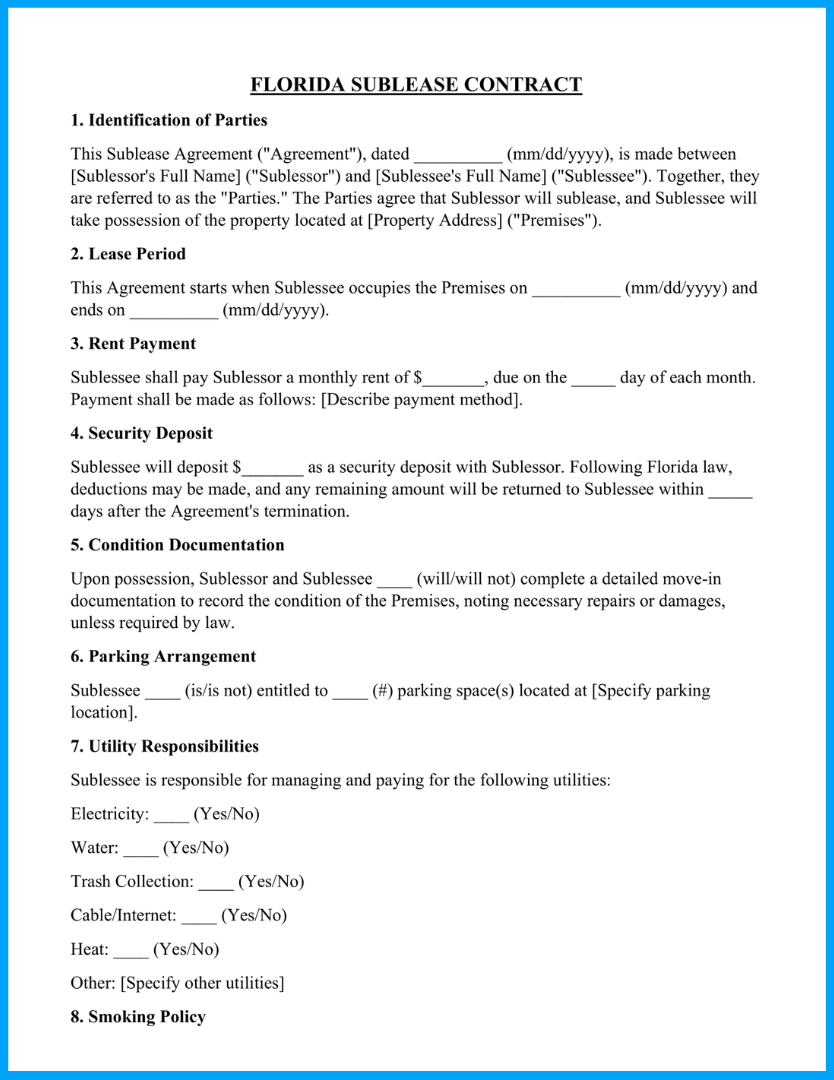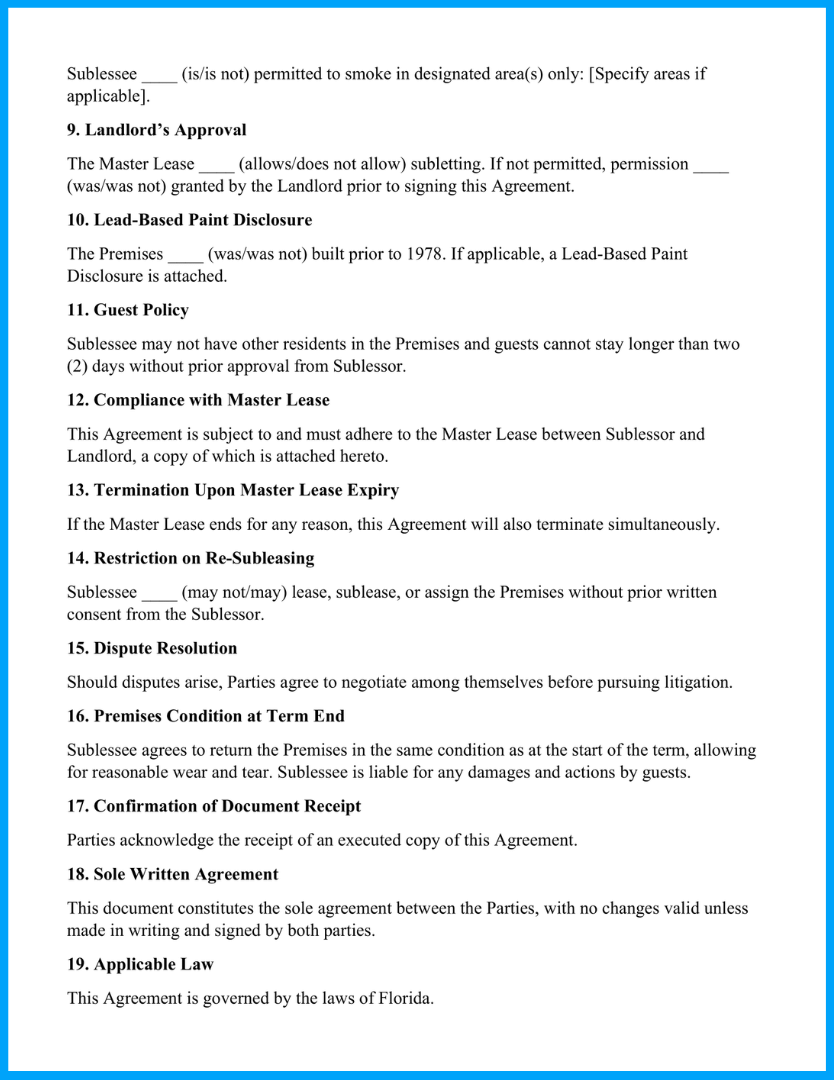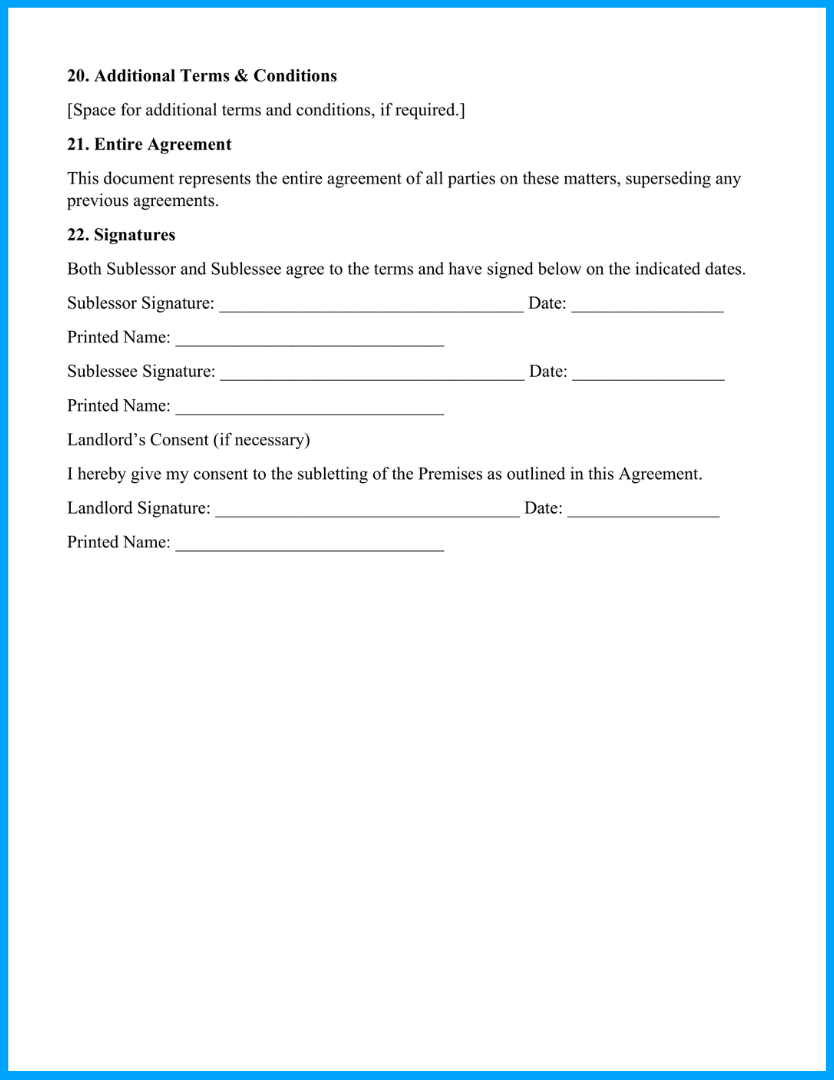Sublease Agreement Florida: Free Template + Essential Information
This guide examines key legal and logistical aspects of Florida subleasing, including permission protocols, contract components, security deposits, sales tax rules, and more. A tailored Sunshine State sublease agreement template is also provided to streamline the creation of comprehensive agreements.



Right to Sublet: Is Subleasing Legal in Florida?
Subleasing is generally legal in Florida, subject to the terms of the existing master lease agreement and obtaining the landlord’s approval. There is no specific applicable law in Florida prohibiting subletting.
To properly request permission to sublet from the landlord:
- Review the lease contracts for any clauses regarding subletting. Some leases prohibit it entirely.
- Notify the landlord in writing of intent to sublet. Provide details on the proposed subtenant, including:
- Name and contact information
- Rental history
- Employment details
- Reason for subletting
- Request the landlord’s written consent and allow reasonable time for them to consider the request.
- Be prepared to negotiate terms if the landlord has hesitations, such as offering an additional security deposit.
- Obtain the landlord’s written approval before proceeding with a subtenant.
- If approved, draft a separate sublease agreement between the tenant and subtenant.
How Does Subletting Work in Florida?
There is no specific Florida law prohibiting or permitting subletting. A tenant’s right to sublet depends entirely on the terms of the existing Florida sublease agreement template.
The process works as follows:
- Review the lease agreement for any clauses or restrictions related to subletting.
- If subletting is allowed or not mentioned, the tenant can generally proceed with a sublease.
- If subletting is prohibited, the tenant cannot sublet without amending the lease.
- If the lease requires the landlord’s permission, the tenant must request written approval to submit the lease from the landlord. Provide details on the proposed subtenant for the landlord to screen.
Key points:
- Landlords cannot “unreasonably” refuse permission to sublet under Florida state law. However, the original tenant remains responsible for complying with all lease terms during the sublet.
- A written sublease agreement is recommended between the original tenant and subtenant. Requiring a security deposit from the subtenant helps protect the original tenant.
- Subletting without the landlord’s permission can be grounds for eviction.
Special considerations:
- Some leases require the landlord’s explicit consent, not just a reasonable approval digital workflow process.
- Courts have ruled blanket refusals to sublease unreasonable if no good cause. Implicit consent is also possible if the landlord accepts rent from the subtenant.
- Despite the sublease, the original tenant remains liable to the landlord for rent payments and compliance with all lease terms.
Elements of a Sublease Agreement in Florida
A sublease agreement should include specific crucial components to make it legally binding and address key aspects of the arrangement. Outlining rights, responsibilities, and expectations for all parties prevents misunderstandings and disputes.
Sublessor and Sublessee Details
The full legal names and contact details of the original tenant (sublessor) and new tenant (sublessee) should be provided. This clearly identifies the parties involved and establishes legal responsibility in case issues arise. It also enables open communication during the sublet period.
Premise Information
The rental property address, specific areas being subleased, a description of the current property condition, property management, and an inventory of any furnished items should be included. Defining the exact rental space avoids confusion about property boundaries. Documenting the initial condition also provides a basis for assessing any damages that may occur.
Sublease Terms
Clearly outlining the start and end dates of the sublease agreement is critical. Any provisions for renewing or extending the term should also be addressed. Additionally, noting any use restrictions or special conditions applicable to the subtenant and referencing the original master lease defines the scope and limitations of the sublease. This establishes clear expectations for the duration of the arrangement and its relationship to the main lease.
Rent & Payment
The Florida sublease agreement template should clearly state the monthly rent amount and due date. Acceptable payment methods, late fee policy, and any grace periods for late payment should also be addressed. Additionally, clarifying whether any utilities are included in the rent or responsibility of the subtenant helps set proper financial expectations. Details on the security deposit amount and terms for handling should also be outlined.
Clearly establishing rent policies, fees, utility obligations, and security deposit guidelines is vital for preventing payment disputes or misunderstandings. This sets standards that both parties must meet throughout the master lease agreement term.
Security Deposit
The sublease agreement must specify the security deposit amount the sublessee is required to pay. This section should clearly explain the terms for holding and eventually returning the funds. It is also essential to note conditions for deductions, such as unpaid rent or property damage.
Properly handling security deposit funds and outlining the policies in writing helps ensure compliance with Florida laws. This protects the interests of both the original tenant and sublessee. Florida law requires landlords to return security deposits within 15-30 days after a lease ends, which also applies to sublessors.
Utility & Bills
The sublease agreement should outline which utilities, if any, are included in the rent amount versus the responsibility of the subtenant to pay separately. The process for transferring or sharing any utility accounts should also be addressed.
Defining these terms prevents conflicts over utility payments. Making expectations clear regarding utility costs ensures continuous service through the sublet period. Listing specifics in the written agreement creates accountability for both parties.
Landlord Consent & Master Lease
If the original lease requires landlord approval to sublet, their written consent should be noted in the sublease agreement. Referencing applicable terms, conditions, and rules in the master lease informs the sublessee of those obligations. Attaching a copy of the master lease as an exhibit is also advisable.
Documenting the landlord’s permission and highlighting the incorporation of the original lease is critical for legal validity. This ensures the sublessee is aware of all governing rules and requirements across both agreements.
Extra Provisions
Addressing logistical considerations in the property, such as parking, smoking policies, pets, guests, and noise restrictions, sets clear boundaries. Outlining maintenance responsibilities also prevents confusion over who handles certain issues.
Clearly stating these extra provisions enhances liveability and prevents disputes. For multifamily properties, clarifying expectations around noise and guests and using restrictions facilitates positive neighbor relations.
Property Inventory
The sublease agreement should contain a detailed inventory of furnishings, appliances, and equipment included with the rental unit. Listing the present condition of items at the start of the lease provides a record for reference.
Maintaining these legal documents protects both parties if damages or missing items become a concern. It also ensures the sublessee accurately returns the unit and its contents to the original state when vacating.
Dispute Resolution & Liability
The sublease agreement should outline the process for resolving disputes should they arise, such as mediation or arbitration. Liability clauses clearly define financial responsibilities in the case of damages, whether caused by the sublessee, guests, etc.
Establishing procedures for handling conflicts and outlining accountability upfront can help avoid drawn-out legal proceedings down the road. This provides reassurance to both parties entering the lease.
Signatures
The sublessor’s and sublessee’s signatures, with the date signed, are required to legally validate the sublease agreement. The landlord’s signature may also be mandatory if consent is required. Using an e-signature service like Signaturely can facilitate remote, online lease signing.
Obtaining proper signatures binds all parties to the terms and conditions stated. This also ensures the agreement can be enforced in a court of law if necessary. Confirming final consent electronically provides convenience while still carrying legal weight.
Additional Considerations for Florida Sublets
There are some specific laws and requirements to consider when subletting rental property in Florida:
- Lead-Based Paint Notice: Federal and Florida law require landlords and sublessors to disclose known lead-based paint hazards in properties built before 1978. Sublessees must receive a written warning notice about potential hazards before signing.
- Obtaining Permission: Florida law generally requires explicit written consent from the landlord before subletting. The landlord can reject a proposed subtenant for reasonable cause, such as a bankruptcy filing or poor references.
- Tax Implications: A short-term Florida sublease agreement of less than 30 days, rented out more than three times per year, is subject to Florida’s 6% sales tax, applicable county taxes, and a local county tourist tax. A license from the state is required for operating short-term rental properties.
- Security Deposits: Sublessors in Florida must return security deposit funds within 15 days if no deductions are made or 30 days if deductions are taken, accompanied by a written statement justifying deductions.
- Notices: Three days’ written notice is required in Florida for a sublessor to demand rent payment or evict a sublessee. Prescribed notice periods for lease non-renewal depend on the rental payment frequency.
How to Write a Sublease Agreement for Florida
The easiest and most reliable way to create a Florida sublease agreement is to use a template. Sublease agreement templates include all the necessary standardized elements and help ensure compliance with state laws.
The key steps for using a Florida sublease room rental agreement template effectively are:
- Choose a reputable Florida-specific template from a trusted provider. This ensures all crucial elements are covered.
- Accurately fill in details on the sublessor, sublessee, property, lease terms, rent, deposit, utilities, and any extra provisions.
- Review and customize the final Florida sublease agreement template to fit your specific sublet situation.
- Verify compliance with Florida landlord-tenant regulations.
- Obtain signatures from all parties, electronically (e.g., Signaturely) or physically.
The main benefits of using a tailored one-page lease agreement template include:
- Time Savings – Pre-determined outline completed upfront
- Reduced Risk – Omission of key items less likely
- Legal Compliance – Aligns with state rental laws
- Ease of Use – Provides structure for inexperienced sublessors
Following a Florida-specific rental agreement template helps streamline sublease creation while protecting all parties involved. Conforming to statutes and norms can prevent issues.
Tax Implications for Subleasing in Florida
There are several tax considerations and legal requirements to keep in mind when subletting property in Florida:
Sales Tax on Rent
- Florida imposes a 6% state sales tax on total rent charged under any lease or sublease.
- Additional “discretionary sales surtax” applies in most counties, ranging from 0.5% to 1.5%.
- The sublessor is responsible for collecting and remitting the sales tax to the Florida Department of Revenue.
Short-Term Rentals
Rentals for 30 days or less, rented more than three times per year, are deemed short-term. Short-term rentals are subject to state sales tax (6%), county tax, and local “tourist tax.”
A license from the state is required to operate short-term rentals.
Other Taxable Charges
Common maintenance fees, insurance premiums, utility payments (if included in rent), and property taxes may also be taxable.
Reporting and Compliance
Proper legal documents of all charges is essential to avoid misclassification and ensure compliance.
Relevant State Laws
Lead paint disclosure rules, landlord permission requirements, and security deposit handling procedures are examples of legal considerations. So, while subletting can provide useful income, Florida sublessors must factor in applicable sales taxes and adhere to laws like any landlord. Careful record-keeping is key.
Download our free example
Sublease Agreement Florida
We’ve got your back here at Signaturely, and we’re ready to help make stress-free contracts a reality. Forget the confusing paperwork and overwhelming legal jargon – get easy, breezy contract templates in minutes with our free template.
What You Need to Remember About a Sublease Agreement Florida
Properly subletting property in Florida requires strict adherence to laws and best practices in areas ranging from landlord approvals to rental rates to tax implications. This overview, along with the accessible yearly or month-to-month rental agreement template, equips parties with the core knowledge essential for coordinating compliant occupant transfers. Signaturely enables secure sending of documents for this process to go even smoother.
FAQs About Florida Sublease Agreements
Subleasing property can bring up many legal questions. Here are answers to some frequently asked questions:
What is a month-to-month sublease agreement in Florida?
A month-to-month sublease automatically renews each month until either party provides a written 30-day notice to terminate. This offers flexibility but less stability than a fixed-term Florida sublease agreement template. The same general laws apply.
Can I sublet my apartment without telling my landlord in Florida?
This is not recommended or legal in most leases. Most rental agreements require the landlord’s written consent before subletting the property. Doing so covertly risks eviction. Always get the landlord’s permission first.
Can I write my own lease agreement in Florida?
Yes, you can create your own Florida sublease agreement template, but using an attorney or template is best to comply with Florida state law. Essential provisions on rent, deposits, rights, and liability must be included per statutes. Having a lawyer review a self-drafted lease improves enforceability.
Can a tenant evict a subtenant in Florida?
As the property’s original tenant, a sublessor retains the right to evict a non-compliant sublessee. However, proper notice must be given based on the reason, typically three days for unpaid rent. Going through the court system is mandatory, even for a sublandlord. The sublessor remains accountable to their own landlord regardless.
Free Florida Sublease Agreement Template
FLORIDA SUBLEASE CONTRACT
- Identification of Parties
This Sublease Agreement (“Agreement”), dated __________ (mm/dd/yyyy), is made between [Sublessor’s Full Name] (“Sublessor”) and [Sublessee’s Full Name] (“Sublessee”). Together, they are referred to as the “Parties.” The Parties agree that Sublessor will sublease, and Sublessee will take possession of the property located at [Property Address] (“Premises”).
- Lease Period
This Agreement starts when Sublessee occupies the Premises on __________ (mm/dd/yyyy) and ends on __________ (mm/dd/yyyy).
- Rent Payment
Sublessee shall pay Sublessor a monthly rent of $_______, due on the _____ day of each month. Payment shall be made as follows: [Describe payment method].
- Security Deposit
Sublessee will deposit $_______ as a security deposit with Sublessor. Following Florida law, deductions may be made, and any remaining amount will be returned to Sublessee within _____ days after the Agreement’s termination.
- Condition Documentation
Upon possession, Sublessor and Sublessee ____ (will/will not) complete a detailed move-in documentation to record the condition of the Premises, noting necessary repairs or damages, unless required by law.
- Parking Arrangement
Sublessee ____ (is/is not) entitled to ____ (#) parking space(s) located at [Specify parking location].
- Utility Responsibilities
Sublessee is responsible for managing and paying for the following utilities:
Electricity: ____ (Yes/No)
Water: ____ (Yes/No)
Trash Collection: ____ (Yes/No)
Cable/Internet: ____ (Yes/No)
Heat: ____ (Yes/No)
Other: [Specify other utilities]
- Smoking Policy
Sublessee ____ (is/is not) permitted to smoke in designated area(s) only: [Specify areas if applicable].
- Landlord’s Approval
The Master Lease ____ (allows/does not allow) subletting. If not permitted, permission ____ (was/was not) granted by the Landlord prior to signing this Agreement.
- Lead-Based Paint Disclosure
The Premises ____ (was/was not) built prior to 1978. If applicable, a Lead-Based Paint Disclosure is attached.
- Guest Policy
Sublessee may not have other residents in the Premises and guests cannot stay longer than two (2) days without prior approval from Sublessor.
- Compliance with Master Lease
This Agreement is subject to and must adhere to the Master Lease between Sublessor and Landlord, a copy of which is attached hereto.
- Termination Upon Master Lease Expiry
If the Master Lease ends for any reason, this Agreement will also terminate simultaneously.
- Restriction on Re-Subleasing
Sublessee ____ (may not/may) lease, sublease, or assign the Premises without prior written consent from the Sublessor.
- Dispute Resolution
Should disputes arise, Parties agree to negotiate among themselves before pursuing litigation.
- Premises Condition at Term End
Sublessee agrees to return the Premises in the same condition as at the start of the term, allowing for reasonable wear and tear. Sublessee is liable for any damages and actions by guests.
- Confirmation of Document Receipt
Parties acknowledge the receipt of an executed copy of this Agreement.
- Sole Written Agreement
This document constitutes the sole agreement between the Parties, with no changes valid unless made in writing and signed by both parties.
- Applicable Law
This Agreement is governed by the laws of Florida.
- Additional Terms & Conditions
[Space for additional terms and conditions, if required.]
- Entire Agreement
This document represents the entire agreement of all parties on these matters, superseding any previous agreements.
- Signatures
Both Sublessor and Sublessee agree to the terms and have signed below on the indicated dates.
Sublessor Signature: __________________________________
Date: _________________
Printed Name: ______________________________
Sublessee Signature: __________________________________
Date: _________________
Printed Name: ______________________________
Landlord’s Consent (if necessary)
I hereby give my consent to the subletting of the Premises as outlined in this Agreement.
Landlord Signature: __________________________________
Date: _________________
Printed Name: ______________________________
Download Our Free Sublease Agreement Florida Template Today
Don’t waste any more time trying to craft the perfect sublease agreement florida template. Our simple sublease agreement florida template is ready and ready to download in one quick, convenient click—no more complicated documents for you or your clients to fill out.
Just download, customize, and off you go!